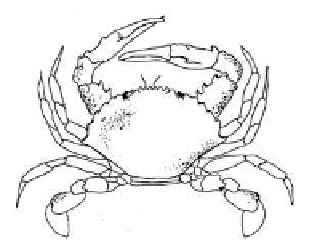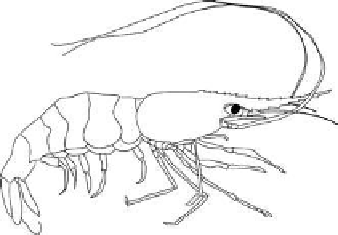Biology Reference
In-Depth Information
1
Head (9-12%)
Food, meal, oil
2
Meat portion (30-40%)
Food (fi llet / mince / steak), meal, oil
6
3
Visceral mass (5-15%)
4
6
Fish meal, food (fi sh sauce), oil, enzymes
2
1
5
Skin & Scales (3-8%)
4
3
6
Collagen, gelatin, leather
6
5
Bones (10-20%)
Meal, collagen, gelatin
6
Fins (3-6%)
Meal, oil, collagen, gelatin
Head shell waste (35-40%)
Chitin, chitosan carotenoids, enzymes
Meat portion (40-45%)
Food (fi llet / mince / steak), meal, oil
Body carapace (5-10%)
Chitin, chitosan, carotenoids
Skin & Scales (3-8%)
Collagen, gelatin, leather
Ovaries
3
1
Shell (30-40%)
3
Chitin, calcium, carotenoid
2
Meat portion (20-35%)
Food
3
1
Claw (5-15%)
2
Food, chitin, calcium, carotenoid
4
Ovaries (5-15%)
Food, protein, enzymes, carotenoids
4
Fig. 10.1
Finfi sh and crustacean shellfi sh by-products and their possible uses. (
Values shown
in the fi gure are compiled from various authors mentioned elsewhere in the text
).
CHARACTERISTICS OF FISH INDUSTRY WASTES WITH
REFERENCE TO BIOACTIVE MOLECULES
Fish wastes remain a source of bioactive materials that include
proteinaceous, lipid based and other bioactive compounds. These include
peptides/amino acids, carotenoids, vitamins, antioxidants and minerals
(Hurst, 2006). Some of the important bioactive materials that can be
derived from fi sh processing wastes are discussed in brief in this section.
For detailed information on these bioactive materials of aquatic origin,




